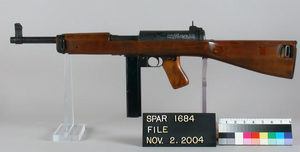
A submachine gun (SMG) is a magazine-fed, automatic carbine designed to fire handgun cartridges. The term "submachine gun" was coined by John T. Thompson, the inventor of the Thompson submachine gun, to describe its design concept as an automatic firearm with notably less firepower than a machine gun. As a machine gun must fire rifle cartridges to be classified as such, submachine guns are not considered machine guns.

The Thompson submachine gun is a blowback-operated, air-cooled, magazine-fed selective-fire submachine gun, invented by United States Army Brigadier general John T. Thompson in 1918. It was originally designed to break the stalemate of trench warfare of World War I, but was not finished until after the war ended.

The M1 carbine is a lightweight semi-automatic carbine that was a standard firearm for the U.S. military during World War II, the Korean War and the Vietnam War. The M1 carbine was produced in several variants and was widely used by paramilitary and police forces around the world, and also became a popular civilian firearm after World War II.
The STEN is a family of British submachine guns chambered in 9×19mm which were used extensively by British and Commonwealth forces throughout World War II and the Korean War. They had a simple design and very low production cost, making them effective insurgency weapons for resistance groups, and they continue to see usage to this day by irregular military forces. The Sten served as the basis for the Sterling submachine gun, which replaced the Sten in British service until the 1990s, when it, and all other submachine guns, were replaced by the SA80.

Jean Cantius Garand, also known as John C. Garand, was a Québec-born American designer of firearms who created the M1 Garand, a semi-automatic rifle that was widely used by the U.S. Army and U.S. Marine Corps during both World War II and the Korean War.

The M1903 Springfield, officially the United States Rifle, Caliber .30-06, Model 1903, is an American five-round magazine-fed, bolt-action service repeating rifle, used primarily during the first half of the 20th century.

The .45 Reising submachine gun was manufactured by Harrington & Richardson (H&R) Arms Company in Worcester, Massachusetts, USA, and was designed and patented by Eugene Reising in 1940. The three versions of the weapon were the Model 50, the folding stock Model 55, and the semiautomatic Model 60 rifle. Over 100,000 Reisings were ordered during World War II, and were initially used by the United States Navy, Marine Corps, and the United States Coast Guard, though some were shipped to Canadian, Soviet, and other allied forces to fight the Axis powers.

The Pedersen device was an experimental weapon attachment for the M1903 Springfield bolt action rifle that allowed it to fire a .30 caliber (7.62 mm) pistol-type cartridge in semi-automatic mode. The attachment was developed to allow an infantryman to convert "their rifle to a form of submachine gun or automatic rifle" in approximately 15 seconds.
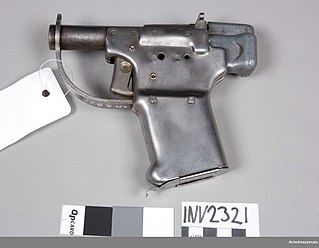
The FP-45 Liberator is a pistol manufactured by the United States military during World War II for use by resistance forces in occupied territories. The Liberator was never issued to American or other Allied troops, and there are few documented instances of the weapon being used for its intended purpose; though the intended recipients, irregulars and resistance fighters, rarely kept detailed records due to the inherent risks if the records were captured by the enemy. Few FP-45 pistols were distributed as intended, and most were destroyed by Allied forces after the war.
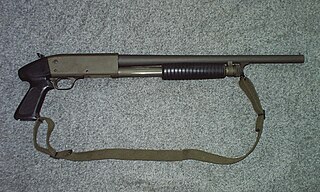
The Ithaca 37 is a pump-action shotgun made in large numbers for the civilian, law enforcement and military markets. Based on a 1915 patent by firearms designer John Browning for a shotgun initially marketed as the Remington Model 17, it utilizes a novel combination ejection/loading port on the bottom of the gun which leaves the sides closed to the elements.
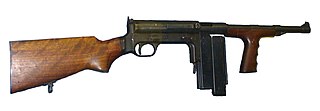
The United Defense M42, sometimes known as the Marlin for the company that did the actual manufacturing, was an American submachine gun used during World War II. It was produced from 1942 to 1943 by United Defense Supply Corp. for possible issue as a replacement for the Thompson submachine gun and was used by agents of the Office of Strategic Services (OSS). However, its usage was limited, and the Thompson continued to see service until the end of the war, alongside the M3 submachine gun, which was designed around the same time as the M42.

David Marshall Williams was an American firearms designer and convicted murderer who invented the floating chamber and the short-stroke piston. Both designs used the high-pressure gas generated in or near the breech of the firearm to operate the action of semi-automatic firearms like the M1 Carbine.
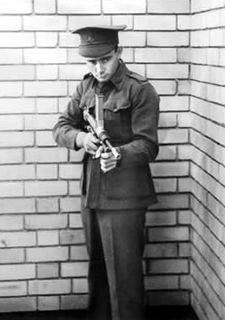
Evelyn Ernest Owen was an Australian who developed the Owen gun which was used by the Australian Army in World War II, Korea and Vietnam wars.

The Mendoza RM2 was a light machine gun similar to the M1918 BAR manufactured in Mexico by Productos Mendoza, S.A. Rafael Mendoza have been producing machine guns for the Mexican Army since 1933 and all have been noted for their lightness, simplicity, ease of maintenance, and economic construction without sacrificing reliability.

The M3 is an American .45-caliber submachine gun adopted by the U.S. Army on 12 December 1942, as the United States Submachine Gun, Cal. .45, M3. The M3 was chambered for the same .45 ACP round fired by the Thompson submachine gun, but was cheaper to mass produce and lighter, although, contrary to popular belief, it was less accurate. The M3 was commonly referred to as the "Grease Gun" or simply "the Greaser," owing to its visual similarity to the mechanic's tool.
The Model 1940 Light Rifle was a military semi-automatic carbine designed for Great Britain in preparation for World War II. The design was not considered suitable for full-scale production. Most trials rifles sent to Great Britain were destroyed at the end of World War II.

Auto-Ordnance is a U.S. arms development firm founded by retired Colonel John T. Thompson of the United States Army Ordnance Department in 1916. Auto-Ordnance is best known for the Thompson submachine gun, used as a military weapon by the Allied forces in World War II, and also notorious as a gangster weapon used during the Roaring Twenties.

The PPS is a family of Soviet submachine guns chambered in 7.62×25mm Tokarev, developed by Alexei Sudayev as a low-cost personal defense weapon for reconnaissance units, vehicle crews and support service personnel.

The Lmg.-Pistole Mod. 1941/44 – also known as Furrer MP 41/44, MP41/44 and LMG-Pistole – was the first submachine gun manufactured in Switzerland for the Swiss Army. The weapon used a complicated toggle-operated short recoil mechanism for its operation and it corresponds to that of the Furrer M25, which is why it is also called Lmg.-Pistole.
George J. Hyde Sr. was a German-born American machinist, gunsmith and gun designer best known for his submachine guns. He was born in Apfingen, Germany. Already a skilled machinist, he immigrated to the United States in 1927. His family followed the next year.
